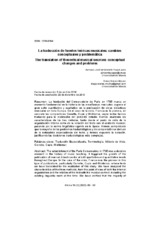Mostrar el registro sencillo del ítem
La traducción de fuentes teóricas musicales: cambios conceptuales y problemática
| dc.contributor.author | Vicente-Yagüe Jara, Antonio José de | |
| dc.contributor.author | Nieves Molina, Diego | |
| dc.date.accessioned | 2020-06-10T09:10:03Z | |
| dc.date.available | 2020-06-10T09:10:03Z | |
| dc.date.issued | 2020 | |
| dc.identifier.issn | 1579-9794 | |
| dc.identifier.uri | http://hdl.handle.net/10396/20148 | |
| dc.description.abstract | La fundación del Conservatorio de París en 1795 marca un momento fundamental en la historia de las enseñanzas musicales: supone el gran salto cuantitativo y cualitativo en la publicación de obras didácticas musicales en toda Europa. En el caso de la viola, Francia es la pionera, en concreto los compositores Corrette, Cupis y Woldemar, cuyos textos hemos traducido para la realización del presente estudio. Hemos analizado las características de los tres métodos, tanto desde el punto de vista de la organización interna como de la relación del texto con el contexto musical, pasando por la norma lingüística vigente en la época. Hemos comprobado que la mayoría de los problemas traductológicos y de comprensión se derivan de la naturaleza especializada del texto, y hemos expuesto la solución, justificando las decisiones traductológicas más complejas. | es_ES |
| dc.description.abstract | The establishment of the Paris Conservatory in 1795 was a decisive moment in the history of music teaching: it triggered the growth of the publication of musical didactic works at both qualitative and quantitative levels throughout Europe. In the case of the viola, France was the pioneer in this type of publications, particularly Corrette, Cupis and Woldemar, whose texts we have translated for the realization of this study. We have analysed the characteristics of the three methods, from the point of view of both the internal organization and the relation of the text with the musical context, including the existing linguistic norm at the time. We have verified that the majority of translation and comprehension problems stem from the specialised nature of the text, and we have suggested solutions, justifying the more complex translation decisions. | es_ES |
| dc.format.mimetype | application/pdf | es_ES |
| dc.language.iso | spa | es_ES |
| dc.publisher | UCOPress | es_ES |
| dc.rights | https://creativecommons.org/licenses/by/4.0/ | es_ES |
| dc.source | Hikma 19(1), 69-93 (2020) | es_ES |
| dc.subject | Traducción especializada | es_ES |
| dc.subject | Terminología | es_ES |
| dc.subject | Método de Viola | es_ES |
| dc.subject | Corrette, Michel, 1707-1795 | es_ES |
| dc.subject | Cupis, Jean-Baptiste, 1711-1788 | es_ES |
| dc.subject | Woldemar, Michel, 1750-1815 | es_ES |
| dc.subject | Specialised translation | es_ES |
| dc.subject | Terminology | es_ES |
| dc.subject | Method of Playing Viola | es_ES |
| dc.title | La traducción de fuentes teóricas musicales: cambios conceptuales y problemática | es_ES |
| dc.title.alternative | The translation of theoretical musical sources: conceptual changes and problems | es_ES |
| dc.type | info:eu-repo/semantics/article | es_ES |
| dc.relation.publisherversion | https://www.uco.es/ucopress/ojs/index.php/hikma/index | es_ES |
| dc.rights.accessRights | info:eu-repo/semantics/openAccess | es_ES |

